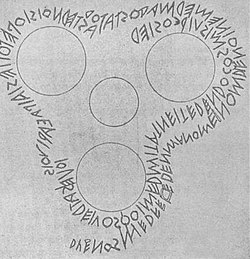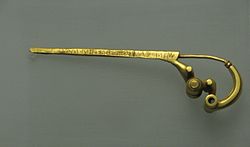Old Latin
Old Latin, also known as Early, Archaic or Priscan Latin (Classical Latin: [prīsca Latīnitās] Error: {{Lang}}: text has italic markup (help)), was the Latin language in the period roughly before 75 BC, i.e. before the age of Classical Latin.[1] It descends from a common Proto-Italic language; Latino-Faliscan is likely a separate branch from Osco-Umbrian with possible further relation to other Italic languages and to Celtic; e.g. the Italo-Celtic hypothesis.
| Old Latin | ||||
|---|---|---|---|---|
| Priscan Latin | ||||
 The Duenos inscription, one of the earliest Old Latin texts | ||||
| Native to | Latium, later the Roman Kingdom and Republic | |||
| Region | Italy | |||
| Ethnicity | Latins, Romans | |||
| Era | Attested since 7th century BC. Developed into Vulgar Latin as colloquial form, and Classical Latin as literary form, around 75 BC. | |||
| Language family | Indo-European
| |||
| Early forms: | ||||
| Writing system | Old Italic script before it evolved into the Latin alphabet | |||
| Official status | ||||
| Official language in | Rome | |||
| Regulated by | Schools of grammar and rhetoric | |||
| Language codes | ||||
| ISO 639-3 | None | |||
| Linguist List | qbb | |||
 Expansion of the Roman Republic during the 2nd century BC. Very little Latin is likely to have been spoken beyond the green area, and other languages were spoken even within it. | ||||
| ||||
The use of "old", "early" and "archaic" has been standard in publications of Old Latin writings since at least the 18th century. The definition is not arbitrary, but the terms refer to spelling conventions and word forms not generally found in works written under the Roman Empire. This article presents some of the major differences.
Old Latin Media
The Praeneste Fibula, the earliest known specimen of the Latin language and dated to the first half of the seventh century BC.
The Forum inscription (Lapis Niger, "black stone"), one of the oldest known Latin inscriptions, from the 6th century BC; it is written boustrophedon, albeit irregularly; from a rubbing by Domenico Comparetti.
The Duenos Inscription on a trio of three globular kernos vases
Diphthong changes from Old Latin (left) to Classical Latin (right)[2]
References
- ↑ "Archaic Latin". The American Heritage Dictionary of the English Language: Fourth Edition.
- ↑ Allen 1897, p. 6.



